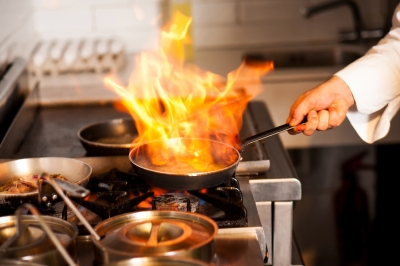It’s hot. Humid. Noisy. Flames rise, people shout. Someone’s holding a knife. It’s pure chaos.

Nope, that’s not a scene from the 1980 classic film Inferno. It’s much more real than that. It’s a scenario that happens daily in restaurant kitchens across the country.
It’s no wonder, then, that the survivability of touchscreen technology in restaurant kitchens is such a hotly debated topic (no pun intended). The kitchen is an incredibly harsh environment overrun by moisture, heat, grease, open flames, and many greasy, grimy hands.
However, as restaurant menus evolve, technology is making the ordering process much more streamlined and efficient. As they invade nearly every aspect of American life, touchscreens are also making their way into restaurants nationwide. The restaurant owner is faced with a question: How do I install this costly technology into a harsh environment such as a kitchen? How much technology to purchase and how to properly place it requires some careful planning and forethought.
Here are 5 tips for adding touchscreen technology to your kitchen:
1. Choose the proper terminal.
It is important to select the proper touch technology. While there are several options to choose from, most manufacturers of the low-cost options do not recommend putting the hardware in the kitchen due to the extreme conditions.
The most important thing to consider when choosing a piece of kitchen hardware is to make sure the touch screen is sealed. If the screen isn’t sealed, you’re going to be replacing that unit very soon.
It’s also important to consider screen functionality. Because kitchen staff depends heavily on utensils and tools, it’s best to choose a system that will respond when something other than a hand is used to navigate the screen.
Finally, consider the casing around the hardware. Plastic gets weak under consistent heat and steam, so something with metal will likely last longer.
2. Be in the right place at the right time.
One of the most common oversights to mounting touch technology into your kitchen is getting the correct type of mount. There are generally two types of mount patterns on the back of most POS terminals: the VESA 75mm and the VESA 100mm. Be sure to get the mount that matches your POS systems pattern.
Next, think about where you want to mount it and if that location will require the screen to move at all. If you want it high and out of the way, you may need an articulating arm to accommodate different heights.
There are a number of different mounts to choose from, including the articulating arm, pole mounts, ceiling mounts, wall mounts, and more. If you can dream it, there’s likely a manufacturer who has made it. Finally, consider that each of these terminals will need power. Be sure to scout a location to mount or hide the power supply in the kitchen.
3. Can’t stand the heat? Get out of the kitchen.
No matter where you go in a restaurant kitchen, heat is always a factor. Range hoods, heat lamps, ovens, and grill tops are all major sources of heat to take into consideration before mounting any hardware in the kitchen. Make sure you understand how your cooks operate and find a placement that will allow them to easily read and interact with the touch screen – but far enough away from any heat sources so it won’t melt.
There are also a number of high-heat terminals out there, so check the manufacturer’s specs for the maximum operating temperature. One critical component that we always recommend to protect your investment: install a stainless steel heat guard that will protect the unit from the high temperatures but still allow airflow to the terminal.
4. Beware the silent killer: moisture.
Like heat, moisture is pretty much a permanent fixture in any restaurant kitchen. Steam tables, hot plates, and standard cooking techniques all create a nightmare environment for electronics.
As with any electronic device, power and water don’t mix. Do not mount any electronic device near a steam table or any area that may be prone to routine spills. If you do get some water or steam on your device, don’t panic – it will likely live. Just be aware that prolonged exposure to such moisture will significantly reduce its usable life.
5. Got the hardware – now what?
There are many pieces of software that will enhance your kitchen staff’s productivity and efficiency. Products such as QSR Automations, Northstar Recipe Viewer, and Logic Control are all pieces of software that can provide your business with more metrics and provide your staff with the information they need to do their jobs. Products like Recipe Viewer provide a digital copy of the recipe into the staff’s work space to create consistency of product across the enterprise.
Touchscreen Technology in the Kitchen
Touchscreen technology will not only make your restaurant even more prepared for the future, it will help it run more efficiently and, in turn, make it more profitable. Touchscreen technology in the kitchen is something that many restaurants have introduced to help reduce error, waste, and inconsistencies.
With touchscreen technology surfacing in nearly every aspect of our lives, your employees will come to expect it in the workplace. A touchscreen kitchen system will reduce training time, increase accuracy, and boost customer satisfaction.
